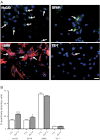Glucagon-like peptide 2 induces vasoactive intestinal polypeptide expression in enteric neurons via phophatidylinositol 3-kinase-γ signaling
- PMID: 22895780
- PMCID: PMC3469609
- DOI: 10.1152/ajpendo.00291.2012
Glucagon-like peptide 2 induces vasoactive intestinal polypeptide expression in enteric neurons via phophatidylinositol 3-kinase-γ signaling
Abstract
Glucagon-like peptide 2 (GLP-2) is an enteroendocrine hormone trophic for intestinal mucosa; it has been shown to increase enteric neuronal expression of vasoactive intestinal polypeptide (VIP) in vivo. We hypothesized that GLP-2 would regulate VIP expression in enteric neurons via a phosphatidylinositol-3 kinase-γ (PI3Kγ) pathway. The mechanism of action of GLP-2 was investigated using primary cultures derived from the submucosal plexus (SMP) of the rat and mouse colon. GLP-2 (10(-8) M) stimulation for 24 h increased the proportion of enteric neurons expressing VIP (GLP-2: 40 ± 6% vs. control: 22 ± 5%). GLP-2 receptor expression was identified by immunohistochemistry on neurons (HuC/D+) and glial cells (GFAP+) but not on smooth muscle or fibroblasts in culture. Over 1-4 h, GLP-2 stimulation of SMP increased phosphorylated Akt/Akt ratios 6.1-fold, phosphorylated ERK/ERK 2.5-fold, and p70S6K 2.2-fold but did not affect intracellular cAMP. PI3Kγ gene deletion or pharmacological blockade of PI3Kγ, mammalian target of rapamycin (mTOR), and MEK/ERK pathways blocked the increase in VIP expression by GLP-2. GLP-2 increased the expression of growth factors and their receptors in SMP cells in culture [IGF-1r (3.2-fold increase), EGFr (5-fold), and ErbB-2-4r (6- to 7-fold)] and ligands [IGF-I (1.5-fold), amphiregulin (2.5-fold), epiregulin (3.2-fold), EGF (7.5-fold), heparin-bound EGF (2.0-fold), β-cellulin (50-fold increase), and neuregulins 2-4 (300-fold increase) (by qRT-PCR)]. We conclude that GLP-2 acts on enteric neurons and glial cells in culture via a PI3Kγ/Akt pathway, stimulating neuronal differentiation via mTOR and ERK pathways, and expression of receptors and ligands for the IGF-I and ErbB pathways.
Figures








Similar articles
-
Intestinotrophic glucagon-like peptide-2 (GLP-2) activates intestinal gene expression and growth factor-dependent pathways independent of the vasoactive intestinal peptide gene in mice.Endocrinology. 2012 Jun;153(6):2623-32. doi: 10.1210/en.2012-1069. Epub 2012 Apr 24. Endocrinology. 2012. PMID: 22535770 Free PMC article.
-
Glucagon-like peptide-2-stimulated protein synthesis through the PI 3-kinase-dependent Akt-mTOR signaling pathway.Am J Physiol Endocrinol Metab. 2011 Mar;300(3):E554-63. doi: 10.1152/ajpendo.00620.2010. Epub 2010 Dec 21. Am J Physiol Endocrinol Metab. 2011. PMID: 21177288 Free PMC article.
-
Mechanism of action of glucagon-like peptide-2 to increase IGF-I mRNA in intestinal subepithelial fibroblasts.Endocrinology. 2011 Feb;152(2):436-46. doi: 10.1210/en.2010-0822. Epub 2010 Dec 15. Endocrinology. 2011. PMID: 21159855 Free PMC article.
-
The "cryptic" mechanism of action of glucagon-like peptide-2.Am J Physiol Gastrointest Liver Physiol. 2011 Jul;301(1):G1-8. doi: 10.1152/ajpgi.00039.2011. Epub 2011 Apr 28. Am J Physiol Gastrointest Liver Physiol. 2011. PMID: 21527727 Review.
-
Frontiers in glucagon-like peptide-2: multiple actions, multiple mediators.Am J Physiol Endocrinol Metab. 2007 Aug;293(2):E460-5. doi: 10.1152/ajpendo.00149.2007. Epub 2007 Jul 24. Am J Physiol Endocrinol Metab. 2007. PMID: 17652153 Review.
Cited by
-
5-HT7 antagonists confer analgesia via suppression of neurotrophin overproduction in submucosal nerves of mouse models with visceral hypersensitivity.J Physiol. 2025 Sep;603(17):4723-4745. doi: 10.1113/JP286444. Epub 2025 Aug 4. J Physiol. 2025. PMID: 40757652 Free PMC article.
-
Gut-Sourced Vasoactive Intestinal Polypeptide Induced by the Activation of α7 Nicotinic Acetylcholine Receptor Substantially Contributes to the Anti-inflammatory Effect of Sinomenine in Collagen-Induced Arthritis.Front Pharmacol. 2018 Jun 26;9:675. doi: 10.3389/fphar.2018.00675. eCollection 2018. Front Pharmacol. 2018. PMID: 29997506 Free PMC article.
-
Computational Design of Potent and Selective d-Peptide Agonists of the Glucagon-like Peptide-2 Receptor.J Med Chem. 2023 Aug 10;66(15):10342-10353. doi: 10.1021/acs.jmedchem.3c00464. Epub 2023 Jul 25. J Med Chem. 2023. PMID: 37491005 Free PMC article.
-
GLP-2 regulation of intestinal lipid handling.Front Physiol. 2024 Feb 14;15:1358625. doi: 10.3389/fphys.2024.1358625. eCollection 2024. Front Physiol. 2024. PMID: 38426205 Free PMC article. Review.
-
Shuidouchi (Fermented Soybean) Fermented in Different Vessels Attenuates HCl/Ethanol-Induced Gastric Mucosal Injury.Molecules. 2015 Nov 2;20(11):19748-63. doi: 10.3390/molecules201119654. Molecules. 2015. PMID: 26540032 Free PMC article.
References
-
- Amin H, Holst JJ, Hartmann B, Wallace L, Sigalet D. Functional ontogeny of the proglucagon derived peptide axis in human neonates. Pediatrics 121: e180–e186, 2008 - PubMed
-
- Anini Y, Izzo A, Oudit GY, Backx PH, Brubaker PL. Role of phosphatidylinositol-3 kinase-γ in the actions of glucagon-like peptide-2 on the murine small intestine. Am J Physiol Endocrinol Metab 292: E1599–E1606, 2007 - PubMed
-
- Birchmeier C. ErbB receptors and the development of the nervous system. Exp Cell Res 315: 611–618, 2009 - PubMed
Publication types
MeSH terms
Substances
Grants and funding
LinkOut - more resources
Full Text Sources
Molecular Biology Databases
Research Materials
Miscellaneous

